Hello everyone! I'm Raoul, a voice-over designer with nine years of experience in the gaming industry, primarily working on AAA games such as the Battlefield & Battlefront franchises. Over the past two years, I've been co-developing Speechless, a VO management system aimed at helping game teams streamline their production processes.
During my time in the industry, I've observed the challenges faced by game teams working with VO. Recognizing the absence of a specialized tool tailored for voice-over workflows, we ventured out to create a solution. This system is meticulously designed to bring structure to the often complex and dynamic nature of game production, addressing the unique needs of voice-over projects. Speechless has gained the support of over 130 studios, allowing me to gain valuable insights into a variety of approaches and processes in the realm of VO.
Join me and a few other VO professionals as we explore the nuts and bolts of voice-over production and how effective tools can elevate your production environment. I will shed light on how the system we've been building enhances the overall efficiency and organization of game projects and seamlessly integrates with Audiokinetic’s Wwise.
The VO Headache
The work of integrating voice-overs into a game is rewarding, but it doesn't come without its fair share of challenges. Without a robust system in place, the chaos that ensues can quickly lead to what I refer to as the "VO headache”.
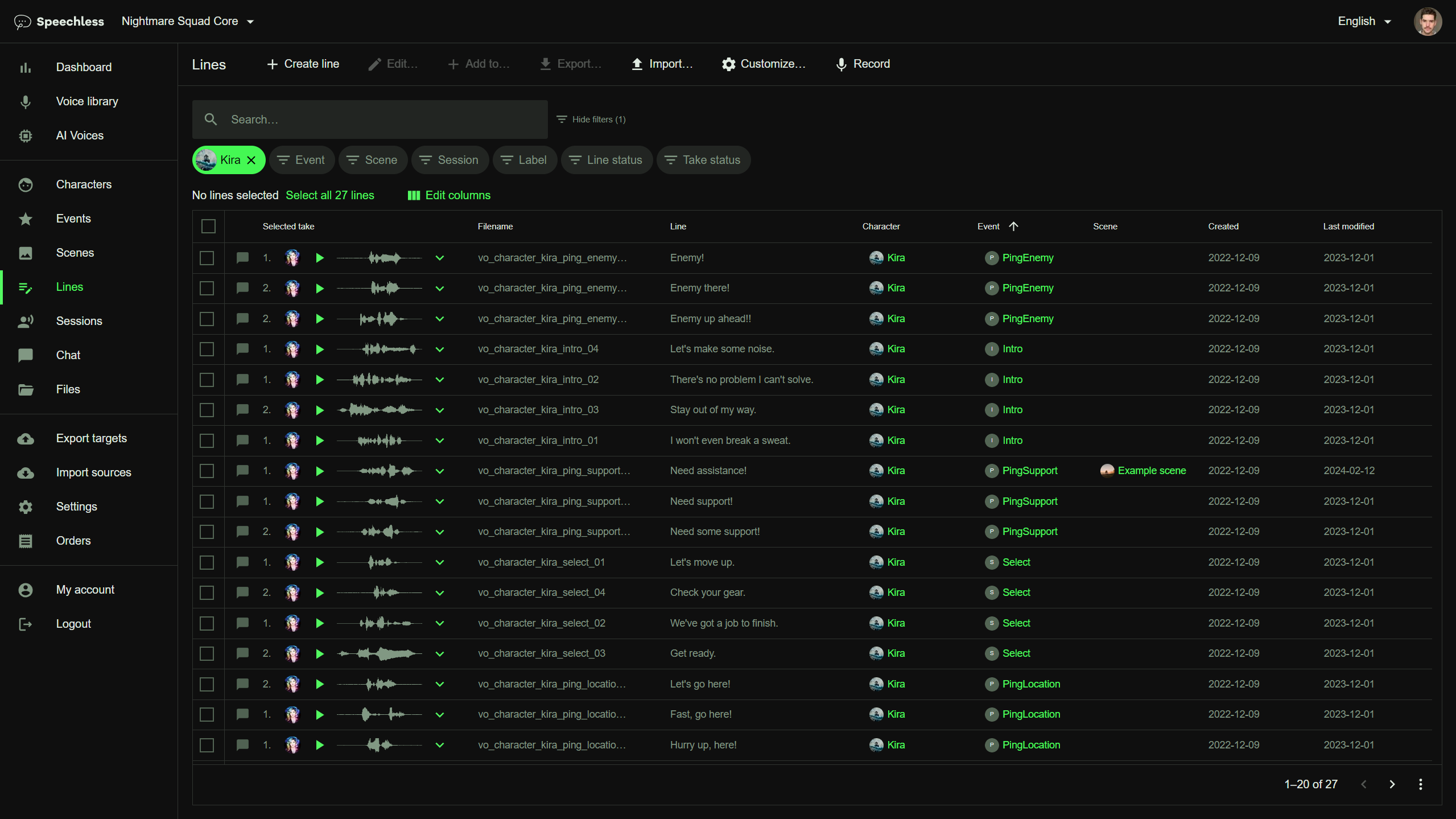
The Speechless Interface
Why? Because iteration is a constant companion. Different iterations, states of audio, and late changes in the development cycle are all business as usual. Without a systematic approach to organization, keeping track of the various voice-over elements can be similar to navigating a maze blindfolded. The challenge intensifies as new lines, revisions, and alternate versions come into play, making it crucial to establish a structured system for seamless organization.
During the production of Battlefront 2, I led the production efforts for the dialogue assigned to playable heroes, involving a multitude of intricate conversations triggered when specific hero pairs encountered each other in the game world. Our solution for tracking these dialogue connections was none other than Excel! However, this choice quickly evolved into a formidable challenge, as substantial time was dedicated to ensuring alignment among writers, narrative teams, and our audio department, while carefully guarding against any changes or errors that might creep in. The last thing you want is to jeopardize the recordings of the iconic Billy Dee Williams' voice and later discover that outdated lines were accidentally recorded; or worse, spend sleepless nights attempting to recover audio files following an HDD breakdown (that might, or might not have happened). "Hello. What have we here?"

Battlefront 2
The significance of effective management cannot be overstated, regardless of the project's size. In both small and large projects, the absence of a streamlined management system can lead to a cascade of issues. Coordinating voice talent, script revisions, and implementing changes on the fly require well-oiled machinery. Without it, the risk of miscommunication and oversights becomes significant, contributing to the development of the dreaded VO headache. Putting aside the physical discomfort (no joke!), it also diminishes the overall project quality, diverting time from creative implementation to less productive tasks.
Speechless & Wwise
With Speechless, we establish an industry standard for voice-over management in games. The system encompasses everything from script management and generating text-to-speech to recording temp audio, casting and recording voice actors, keeping track of all localized versions and syncing it all seamlessly back to our projects.
The recent integration with Wwise marks a significant stride for us in making Speechless a serious tool in the realm of game development. With the Wwise Authoring API, you can seamlessly manage your VO projects from start to finish, ensuring constant data synchronization. Say goodbye to headaches!
A Closer Look at Speechless
Script Management
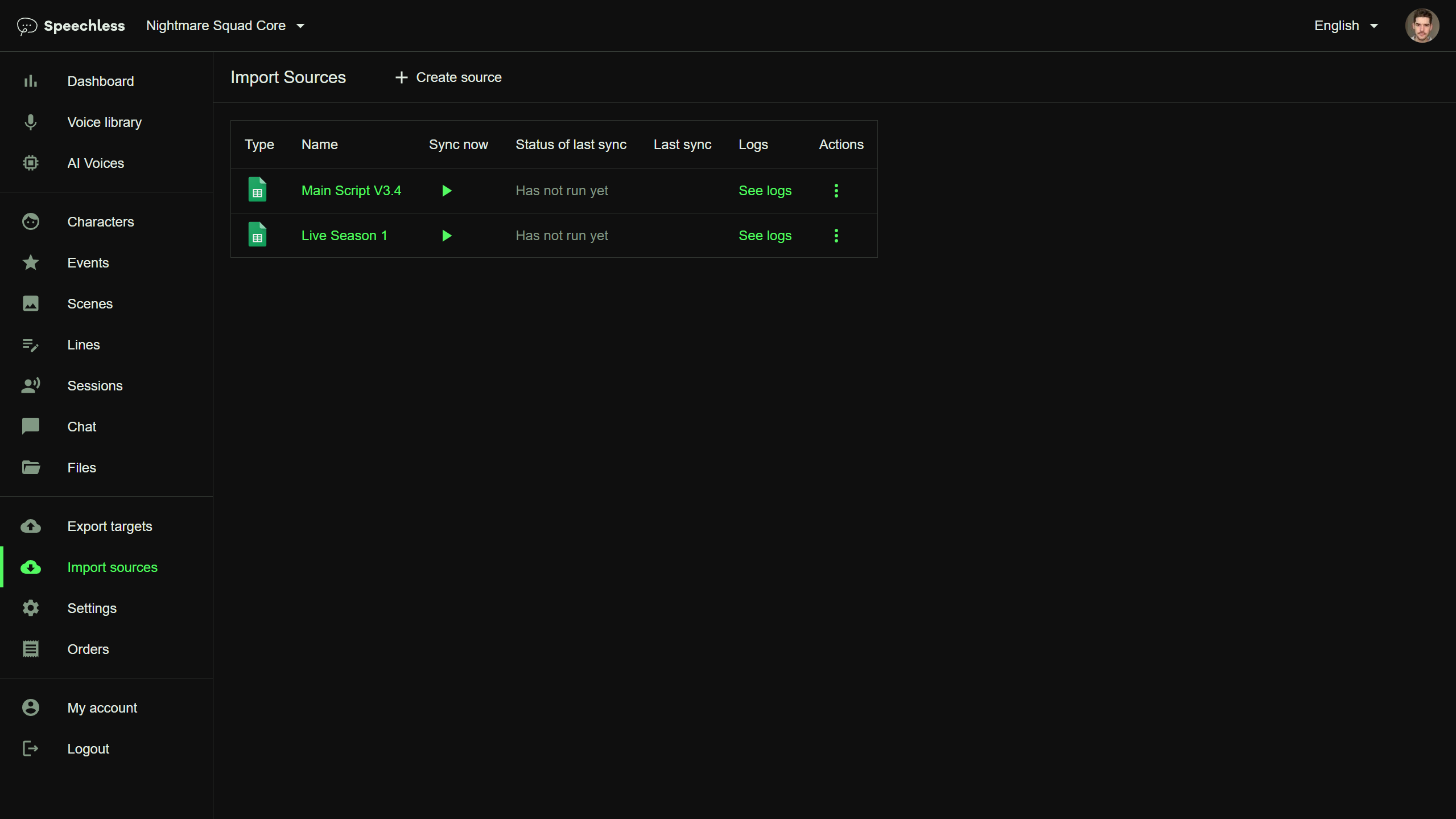
Script Tracking
We built Speechless to support different ways of importing script data, which can be done either manually or automatically by setting up import targets such as Google Sheets. Currently, we support .csv, .xls, and Google Sheets direct sync.
With just one click, you can import script changes and receive detailed information about modifications to existing lines. If you have a direct sync set up with Google Sheets, you don’t have to do anything; it simply updates in the background at your preferred intervals. This feature is highly convenient when working in a team, providing a single location that continually checks for errors and ensures the team is on the same page at all times.
AI & Text-to-Speech
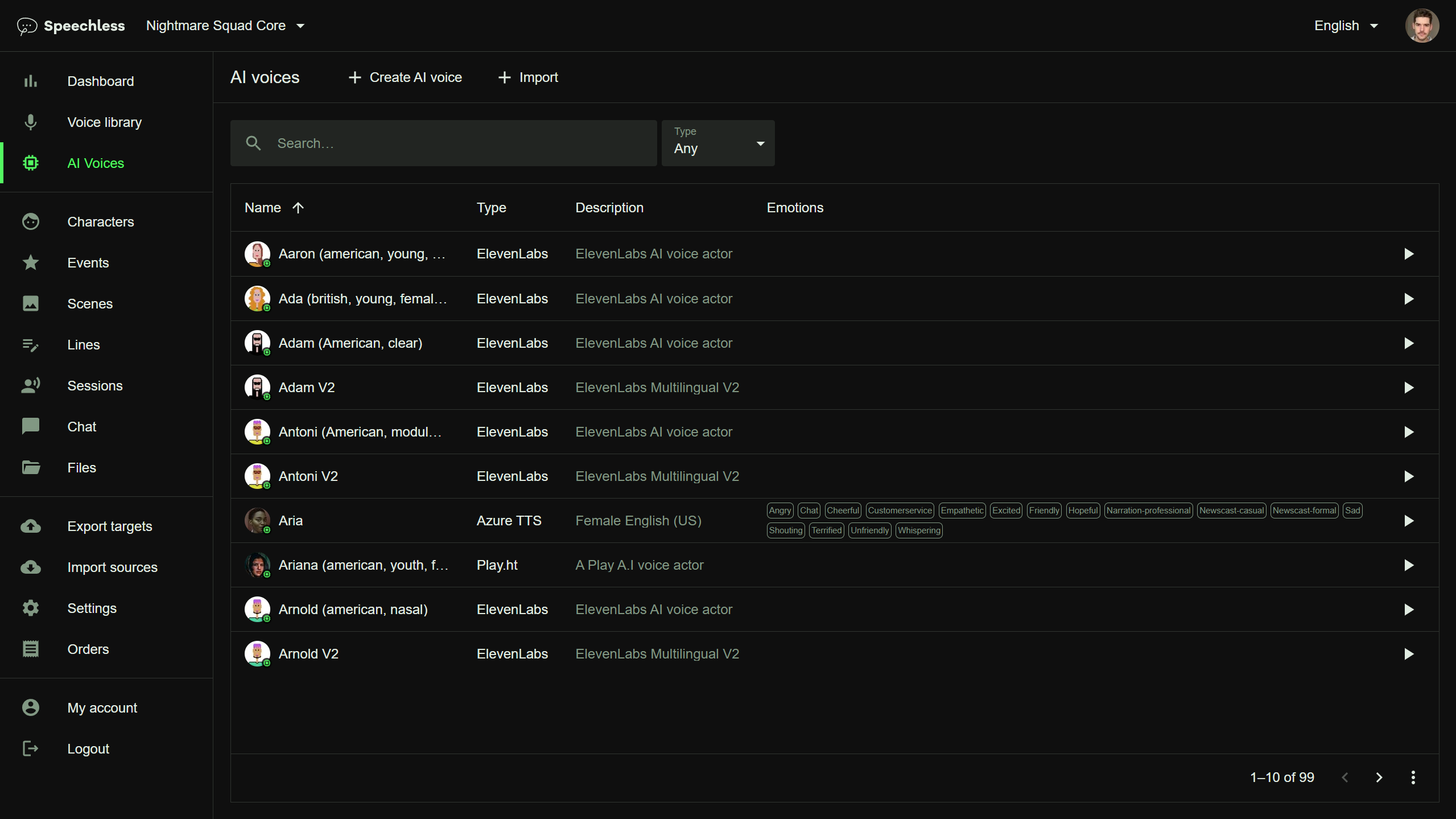
AI & TTS
The next natural step in our ecosystem is to generate TTS (Text-to-Speech) audio from the newly imported script lines. This provides a valuable tool when done automatically, as you don’t have to spend time on your placeholder data.
You can assign a specific AI voice to each unique character in your project. The AI lines are generated automatically as soon as a line is added or updated (preference can be turned off). This eliminates the manual step of ensuring that the placeholder data is up to date. We provide multiple vendors for the TTS, such as ElevenLabs, Microsoft Azure, and Google.
Combining the script management and TTS generation we already have a rather smooth workflow that makes sure that we instantly have access to updated placeholder lines.
Script & Audio Updates
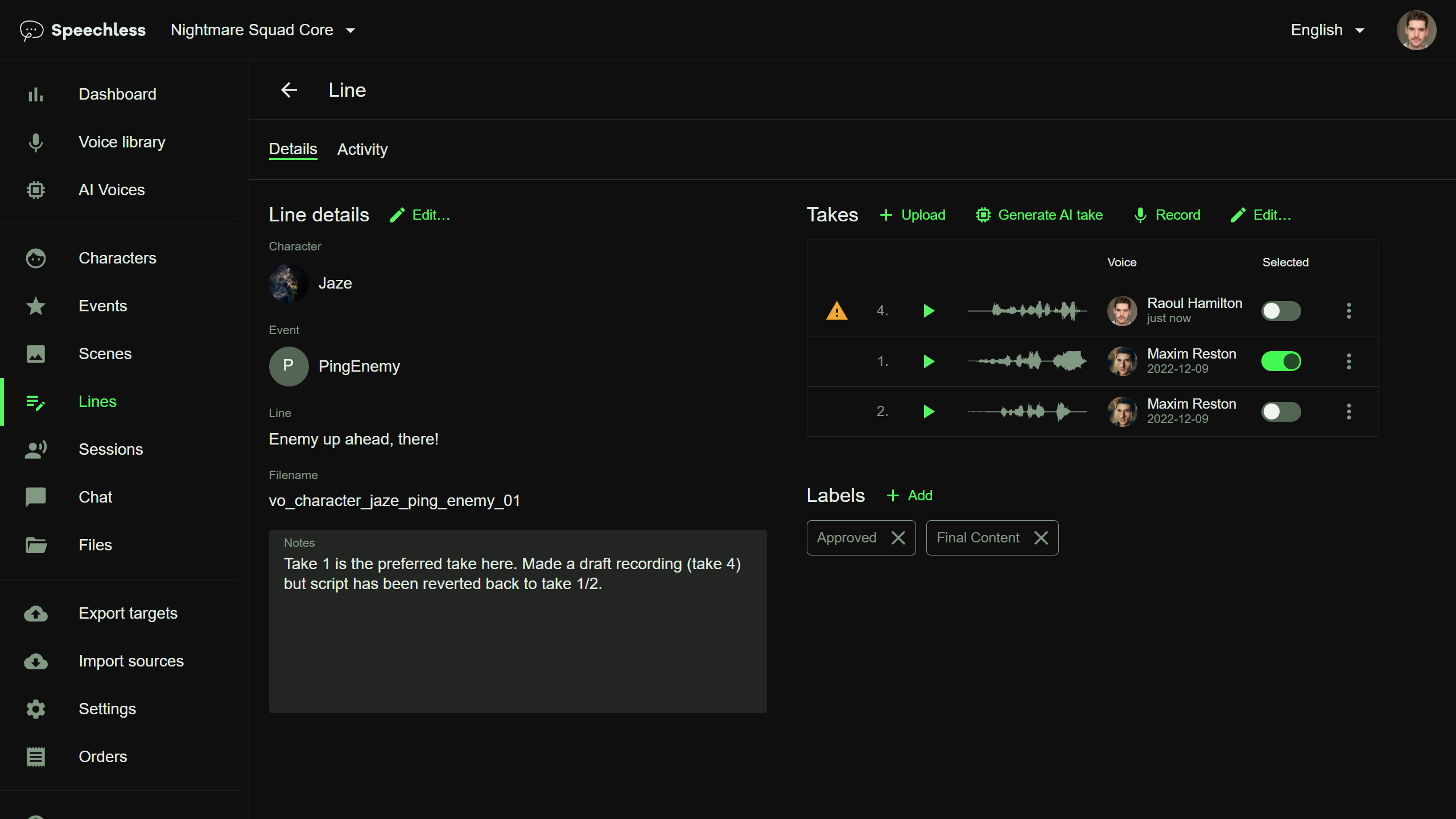
Script / Auto Updates
We aimed to ensure that changes to both the script and audio are always easily visible and accessible. When opening a specific line, the line's history and assigned audio are displayed. This also serves as a robust backup in case data is lost locally. In the image, you can observe that multiple revisions of the line have been made. In this particular instance, Speechless alerts us that all but one line is outdated in relation to the written line.
Effectively managing multiple projects is a well-practiced skill for Franco Freda, Head of Audio at Paradox Interactive. In highlighting the necessity for a comprehensive voiceover tool, he emphasizes the importance of a structured approach. According to him, “A comprehensive tool is not just beneficial; it is crucial in streamlining the complexities of handling various voiceover projects concurrently.”
Collaborating with team members is an essential aspect of any project, and having a dedicated platform to work on can significantly streamline the process. Different team members may focus on various aspects of the pipeline such as scriptwriting, technical implementation, maintaining naming conventions, or logistics. Bringing everything under one centralized location can lead to a more efficient and practical project completion, ensuring that it meets the highest standards every time.
Voice-over Session Recordings
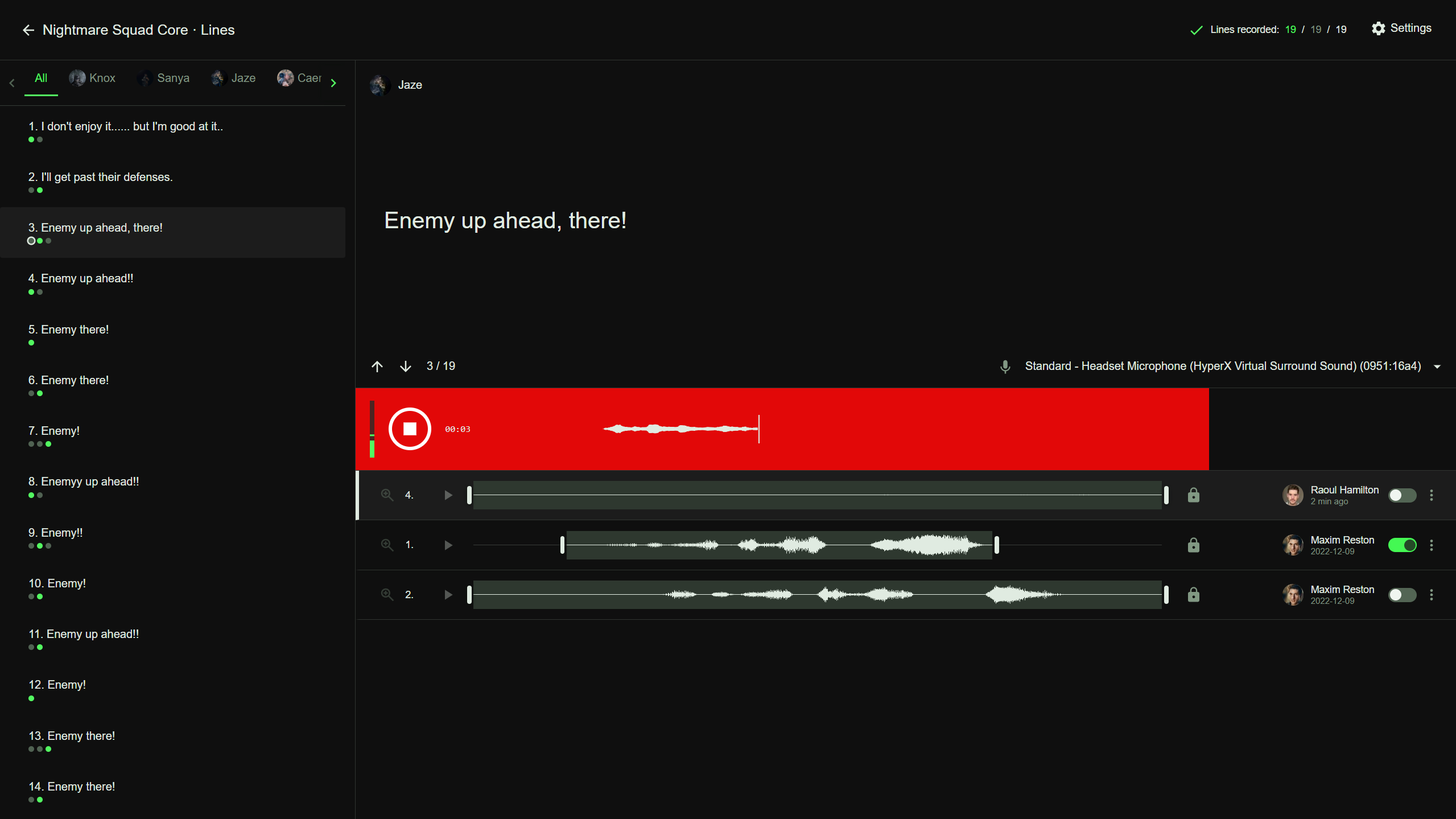
Session Recordings
Whether you record remotely with talents from Speechless or in your go-to studio, you can seamlessly record the takes directly into the platform. This ensures that the audio is labeled and assigned correctly from the get-go, reducing the manual labor of matching audio to the correct written line.
Resolution Games, a leading developer of various VR titles, operates seamlessly under one roof. Linus Söderlund, Audio Director at Resolution, highlights the significance of implementing a robust solution for voice-over work and the value it adds to the team's workflow.
"Having access to actors, regardless of their location, is great. Consolidating everything into a unified system boosts our process, allowing us to efficiently manage multiple projects simultaneously.”
Exporting Audio
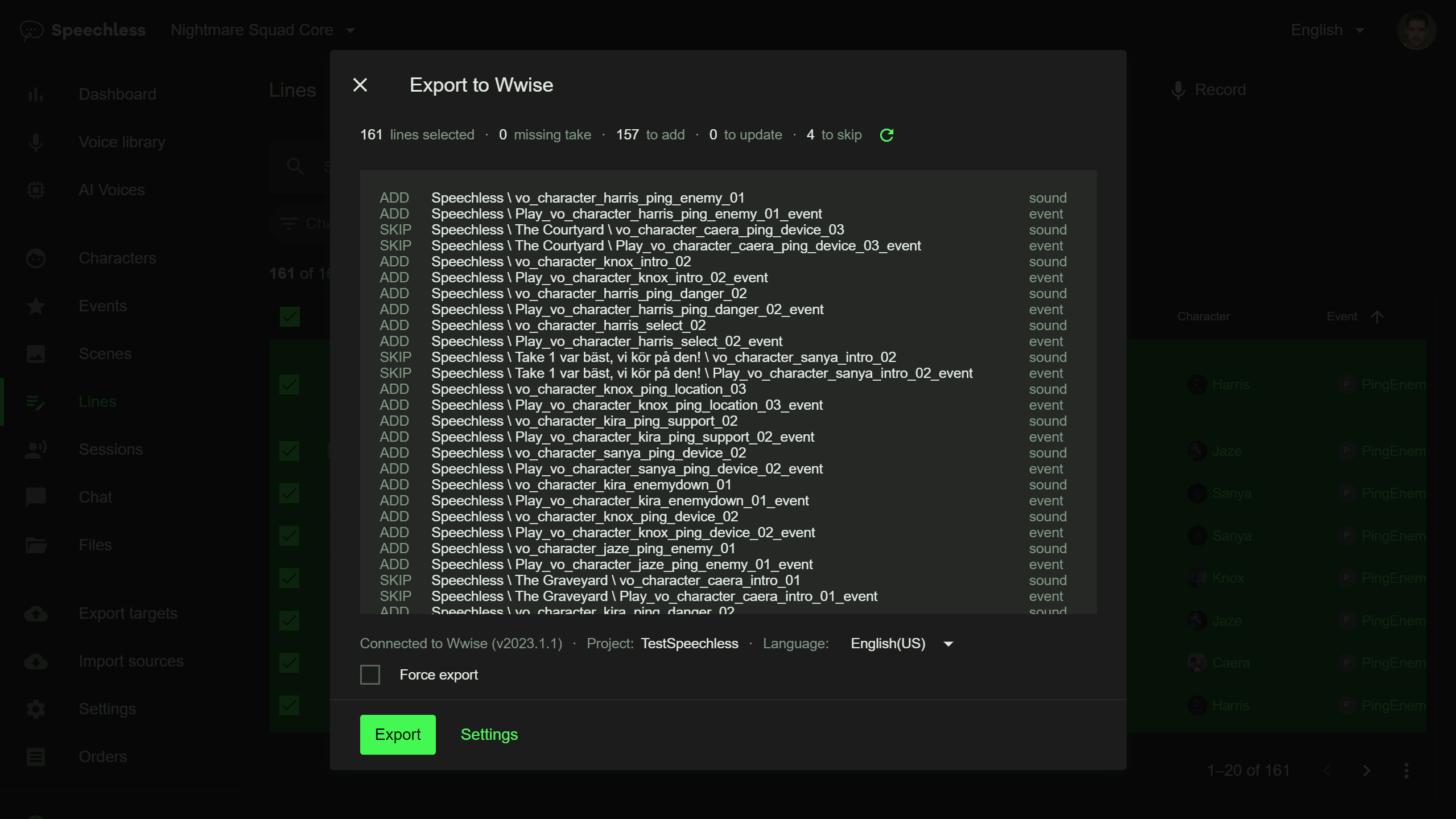
Exporting Audio
Exporting your audio from our ecosystem is of course as important as importing it. Exporting from Speechless can be done automatically or manually, by organizing outgoing data with export targets. You can integrate Speechless directly with Wwise and let the platform make sure what audio needs to be exported, replaced, updated, etc.
Here’s a detailed guide of how to set up Speechless with Wwise.
Getting Started With Speechless & Wwise
Speechless adapts to projects of all sizes, offering a comprehensive solution from script management to casting. Integrated with Wwise, the tool not only saves time and costs but sets an industry standard for voice-over management. Experience the power of Speechless for yourself – visit our website to explore how it can simplify voice-over production for your team.


Comments